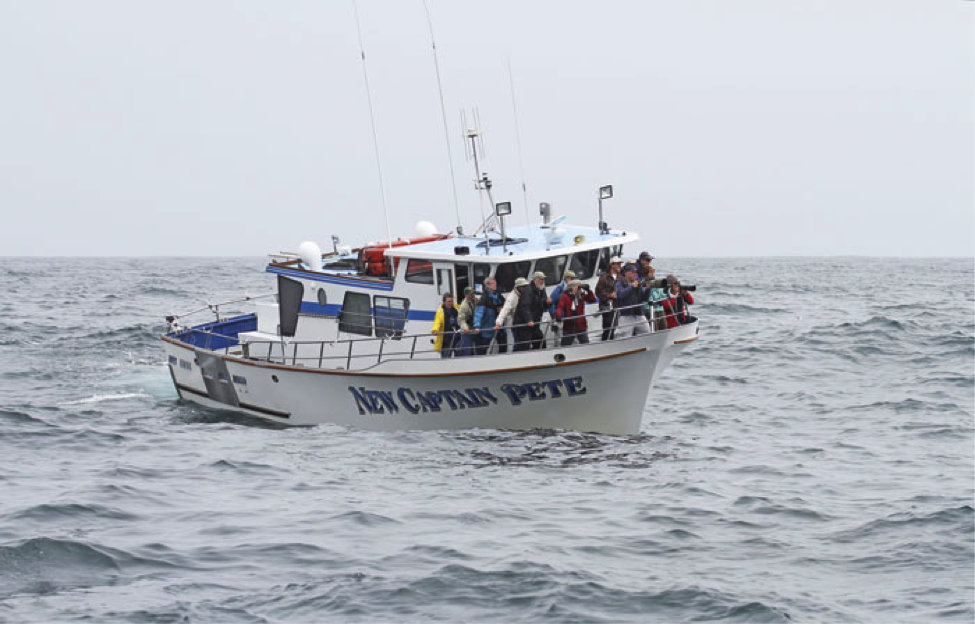The July 2021 Pelagic Bird Spotting Experience for a Struggling Bird Identifier

This is a memoir of a COVID-invigorated Bird Spotter and his July 2021 journey from Half Moon Bay to the pinnacles of the Southeast Farallon Islands, and waters beyond, in search of pelagic birds: puffins, shearwaters, storm-petrels, and albatross.
My thanks go to Alvaro Jaramillo who organized the trip, the crew of the New Captain Pete who took us on the journey, the bird spotters who saved me the effort of using my bird book, and my daughter for her 2021 Father’s Day gift and willingness to accompany me. During the COVID pandemic, I have revived my childhood hobby of birdwatching, but with over 850 species inhabiting the United States, recognition is a very challenging task. Too often, birds disappear before you have time to identify them, so I am still gathering expertise.
The purpose of the trip was to learn how to recognize new Californian pelagic species and to refresh my memory on those pelagic species I had encountered at Spurn Point in England, during the 1960s. Here was an opportunity to travel with experts.
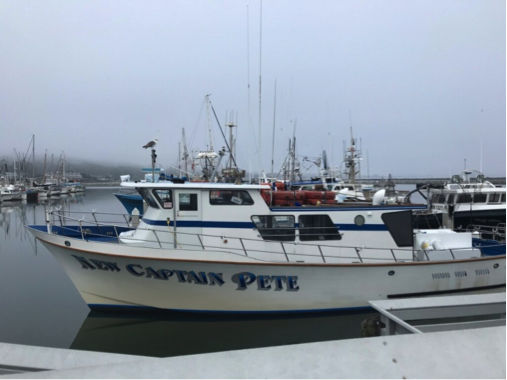
The journey involved an early morning departure, the sky was overcast, the sea was heaving, there was a chilly wind blowing onshore, we were warned of sea sickness once we left the harbor, and told that we would be on board for 10 hours. I had struggled earlier in the morning to decide how many layers of clothing to bring so that I would remain warm but not hot. The boat’s destination was to be a cluster of inhospitable, rocky peaks, about 35 miles from Half Moon Bay, known as the Southeast Farallon Islands, and afterwards we would visit the edge of the continental shelf, several miles to the west. I wondered what might happen.
The expert bird spotters on board quickly reported shorebirds they had identified, even before I had drunk my coffee and the vessel had passed beyond the fog horn at the entrance to Pillar Point Harbor. During late May, 2021, an experiment was begun using sound baffles to lessen the noise of this fog horn, without jeopardizing marine safety, as the authorities responded to resident complaints that the warning signal, given off every 10 seconds, is too loud. Some people argue the noise keeps them awake at night whereas others claim it lulls them to sleep!! Having used a local hotel the night before, I would vote with the former.

Brown pelicans at half moon bay
If you ever want to see brown pelicans, this is the place to visit. There were hundreds along the harbor walls, roosting, preening themselves, communicating with their neighbors, waiting for food, or simply watching passing traffic. Other species identified by my colleagues included a black oystercatcher, wandering tattler, double-crested cormorants, and on the water, pigeon guillemots, common murres, and a pair of marbled murrulets. The occasional Caspian tern, the largest tern in the world, circled above with its head down, before plunge-diving into the water for its breakfast. This was a fine start to the day.

Caspian tern
The birds that caused the most excitement were the two marbled murrulets, about the size of American robins, because of their rarity. Strangely, although it is a seabird that feeds offshore, as well as making use of inshore bays, it nests among the branches of old growth trees from Alaska, south along the Pacific coast, to the Santa Cruz Mountains. Only a single egg is laid, and because of the human destruction of their nesting habitat and their eggs being eaten by ravens and jays, they are now endangered in California. This was a species I had never seen before, and I quietly celebrated as it was added to my life list.
They were no longer present on our return, but other species spotted in the harbor at that time included a ruddy turnstone, surfbird, willets, and a pair of surf scoters.
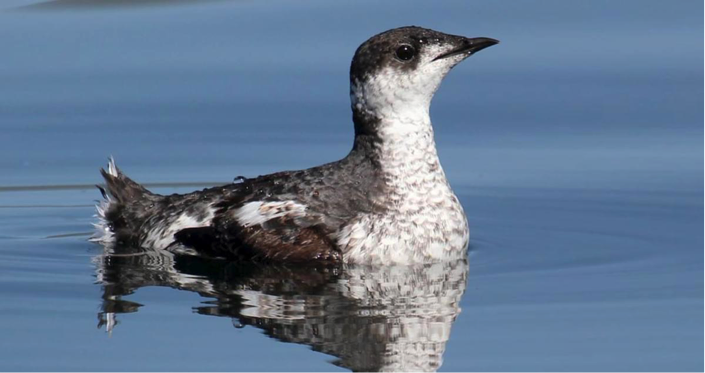
Marbled murrulet
During the journey to the islands, we quickly lost sight of the shorebirds, and left behind the pelicans that rarely feed more than five miles from shore. They were replaced by hundreds of sooty shearwaters, common murres, and pigeon guillemots. No one spoke of the many gulls we saw except for a comment about a Heermann’s gull that was accompanying several brown pelicans, presumably intending to steal their food.
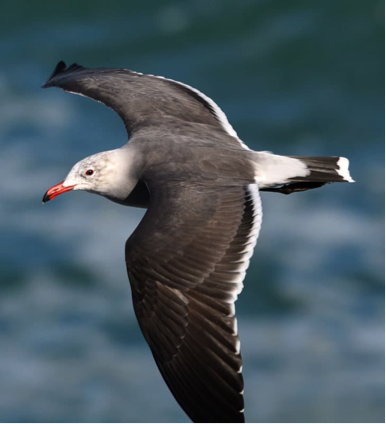
Heerman’s gull
By now, cameras were in use to capture the important ornithological moments, binoculars were gazing out to sea, looking for something new, and the most serious guests were meticulously noting down the species they had spotted and the population count for each variety. Personal breakfasts were in progress, except when food was grabbed by the wind and blown overboard; the less brave rested in the wind-protected cabin, but so far no one was sea sick. The greatest commotions occurred when we passed spouting humpback whales and sighted Pacific white-sided dolphins.
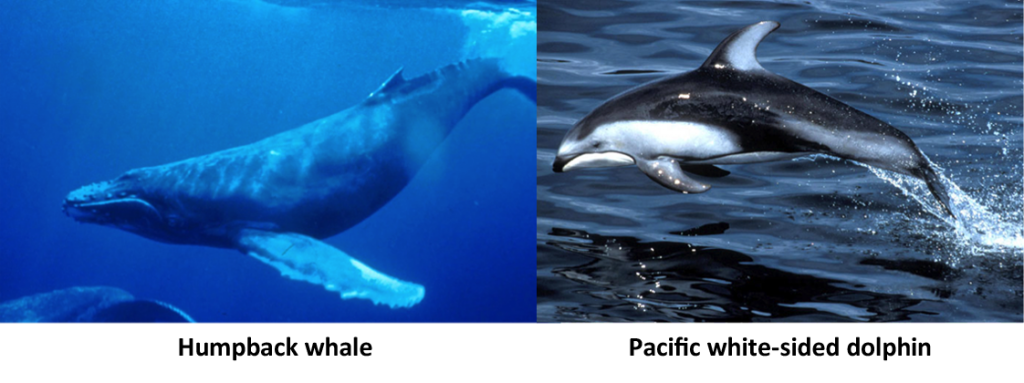
As we came close to the Southeast Farallon Islands, more and more birds appeared in flocks as they returned to their nesting locations. New species appeared such as Northern fulmars, pink-footed shearwaters, Cassin’s and rhinoceros auklets, and red-necked phalaropes. I recall seeing the first and last of these species many years ago at Spurn Point. It was easy to miss the auklets because of their small size and their habit of diving quickly as we approached them. They are one of very few species that can “fly” underwater. Others include common murres, puffins (a type of pelagic bird), dippers, penguins and gannets.
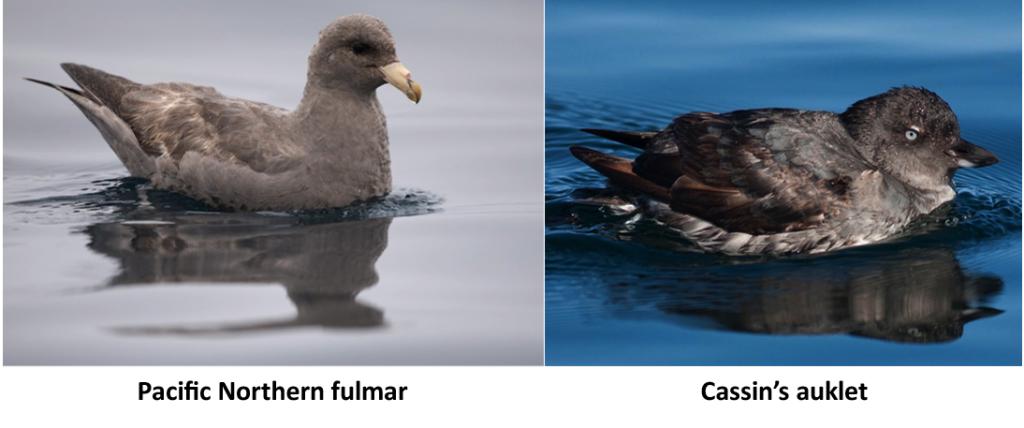
Curiously, no one mentioned the many gulls flying around, such as Western and California gulls, possibly because these birds are regularly seen onshore.
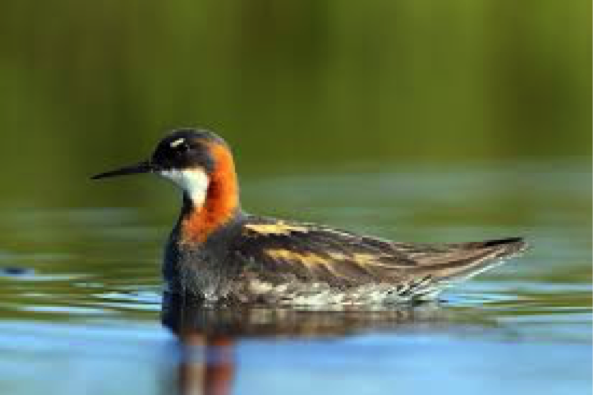
Red necked phalarope
Probably the most memorable sight of the day for me was observing the about 20 small, dainty red-necked phalaropes (slightly larger than a house finch) swimming and spinning on the water. These are very special birds, one of the few species that exhibit reverse sexual dimorphism, with the female displaying the more colorful feathers and being the one that selects the mate. Once she has laid her eggs, she may disappear to find another mate, leaving the original partner to incubate the eggs and to take care of the young chicks.
Even before we arrived at the Farallones – where you are not allowed to land – we sighted our first tufted pelagic bird; a puffin, about the size of a pigeon but twice its weight. It was out fishing but detoured to inspect our boat, using its poorly developed wings that require strong and rapid wingbeats to stay airborne – up to 400 beats a minute. It flew directly towards us staying close to the ocean. More puffins appeared once we were among the Southeast Farallon Islands. They are members of the auk family and are found along open waters, islands, and rocky cliffs of the north Pacific. Population estimates are about 2.5 million birds worldwide. This species is larger than other puffins and each bird has a distinctive white “face mask”, with golden head flumes during the breeding season. Once it finishes breeding, it spends up to eight months out at sea and is rarely seen at this time.
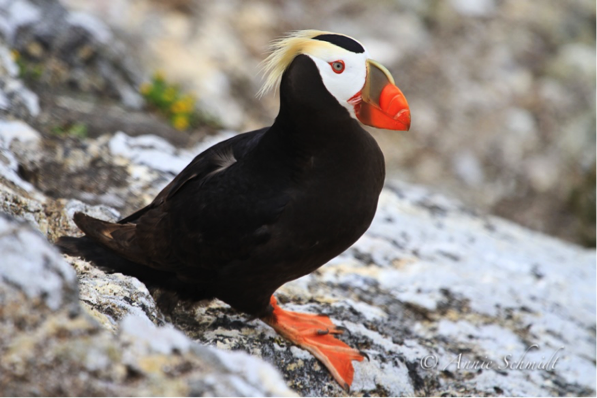
Tufted puffin
The islands are amazing. You are greeted by the unforgettable noises, echoing off the cliffs, of thousands of seals and sea lions, and hundreds of thousands of breeding birds, and you cannot miss the foul smell of their guano. I have never seen anything like it. The islands are home to the largest seabird nesting site in the contiguous United States and the largest colony of Western gulls in the world. Half the world’s population of ashy storm-petrels (another class of bird I added to my life list) is resident here, and more than 400 avian species have been recorded. We entered the relatively calm waters near the islands, and stopped to inspect the wildlife.
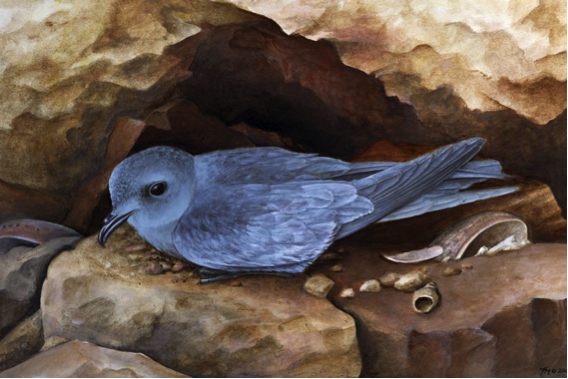
Ashy storm petrel
The jagged peaks and craggy shores, and the sea that surrounds them, teemed with life. Even some gray whales swam by. In the distance, there were huge congregations of common murres, pigeon guillemots, and Western gulls, and nesting colonies of Brandt’s and double-crested cormorants. The latter two species had segregated themselves, with the double-crested cormorants occupying nests higher up the cliff. Technically cormorants are not “pelagic” (i.e. do not inhabit the open sea), because of their need to stay close to the land to dry their non-waterproof feathers.
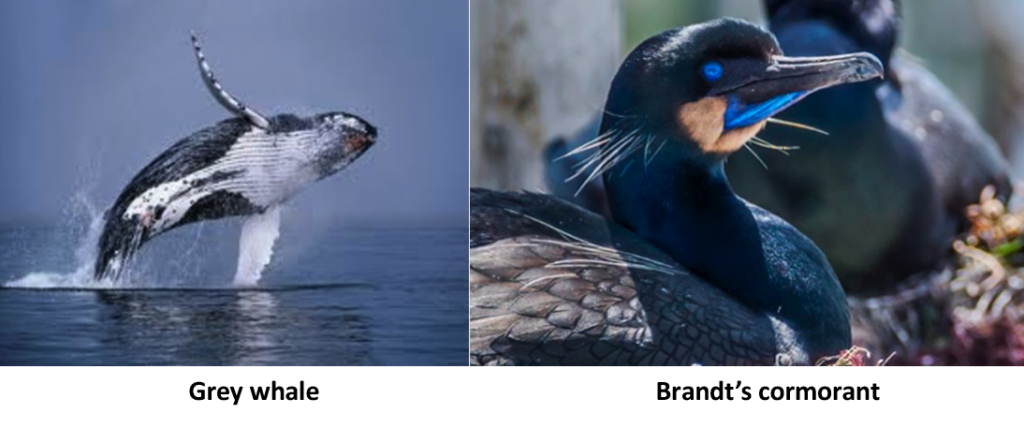
The Southeast Farallon Islands are largely barren, and part of a granite ridge running northwestward that appears above the ocean surface to create this inhospitable archipelago. The granite originated in Cretaceous geologic times, about 100 million years ago, deep under the earth’s surface, apparently in the same magma core that formed the southern Sierra Nevada Mountains (such as Yosemite). This block was torn off far to the south, possibly 300 miles away, and because it was attached to the Pacific Plate, the fragment has slowly drifted north. The boundary between the Pacific Plate and the North American Plate is located a few miles to the east of the Farallon Islands, and is marked by the San Andreas Fault. Estimates are that the islands are moving north, on average, by a little over an inch (3 cm) per year.
These almost inaccessible islands, with sheer cliffs, make you want to discover more about their history. Here is what I found out:
- Native Americans believed the islands were haunted and named them “Islands of the Dead”, and generally stayed away; occasionally, they would take out dead bodies for water burials. Early mariners who encountered the islands called them “Devil’s Teeth”.
- The first “recorded” sighting by a European was Sir Francis Drake on July 24, 1579, when he landed on the islands to collect seal meat and birds eggs. Because the visit was close to the Feast Day of James the Great (one of Jesus’s Twelve Apostles), he named the archipelago the “Islands of Saint James”. It was not until the 1700s when the Spanish substituted the name “Los Farallones de los Frailes” (Rocky Islets of the Brothers), although it is likely that the Spanish visited before and after Sir Francis Drake. Since Spanish sailors were instructed to sail west of the islands, it was not until 1769 that Gasper de Portola discovered the entrance to the San Francisco Bay.
- Human occupation began with Russian and American fur traders during the early 1800s when they and their Alaskan native hunters harvested elephant seals for their blubber and fur seals and sea lions for their pelts, and took birds’ eggs and birds for food.
- During the 1850s, when the population of San Francisco exploded as a result of the 1848 California Gold Rush, the islands became a source of desperately needed food. Seabird eggs were collected by the thousands, and one common murre’s egg could sell for the equivalent of $30 in today’s value. An Egg War broke out as people fought over the rights to collect this food, and in 1863, one company (the Pacific Egg Company) was given sole egg collecting rights. As a result, by the early 1880s, the common murre population had been decimated to the point that only 6,000 birds survived out of an original 500,000. Egging was declared illegal in 1881, but the Southeast Farallon Islands’ Light keepers continued to collect them for some years afterwards as a way of supplementing their government income. Eventually, the practice ceased as demand fell and the Petaluma poultry industry took over the supply of eggs and chicken meat.
- Light keepers arrived on the Southeast Farallones in 1855 when the Lighthouse came into operation, and remained there until 1972. Most brought their wives and children. Early on, the only contact they had with the outside world was the supply ship that visited every three months, and the occasional hellos from sailors on passing vessels.
- In 1909, President Theodore Roosevelt designated some of the Farallones as a national wild life refuge. The largest, the Southeast Farallones, were left out because by then they hosted the US Navy and US Lighthouse Service, but eventually were added in 1969. During World War 11, the Islands became home for the US Military, who erected a radar station and relocated up to 78 personnel to live on the islands. Today, the Farallones remain a protected wild life refuge, and only a few scientific researchers are allowed to stay there.
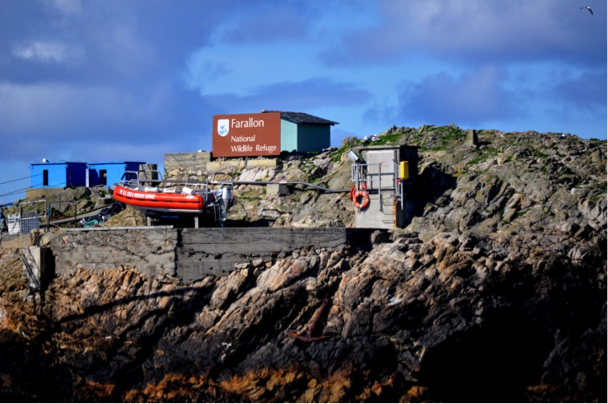
Farallon National Wildlife refuge
- Nearby, are the deep water sites used from 1946 to 1970 to dump radioactive waste, but with the claim that most of the radiation had decayed by 1980.
- Other remnants of the past survive. Feral cats, abandoned by former residents, introduced rabbits and rodents, oil spills and other pollution all compete and threaten the Islands’ native ecosystem. Today, the most significant threat is the invasive house mice, probably first left behind during the 1800s by sailors, and now with an estimated population of 60,000. Their impact on the Islands’ native species is severe, and proposals to eradicate them have been under study for nearly two decades. The recommendation is to drop from helicopters, about 1.5 tons of pellets laced with the controversial rat poison called Brodifacoum. It thins the blood, causing the animal to bleed to death. There is intense opposition from those who worry about the secondary effects that the poison may have on other wildlife. Some non-targeted species will likely consume the pellets, and amounts of bait will fall off the steep rocks into protected waters. Worries are that the Western gulls will scavenge the dead mice, fly to the mainland, and subsequently die of the poison. The chemical is already banned for use on the California mainland. The counter arguments are that the mice prey on the islands’ native animals and eat the seeds of native plants, and therefore need to be eliminated. The presence of these mice has attracted migrating burrowing owls, and one of the concerns is that these birds may turn their attention to the already threatened ashy storm-petrels if the mice disappear. Supporters of the proposal believe these fears are unfounded, and plan to haze birds during the project with spotlights, noise, effigies, etc. to keep them away from the poison; they argue that total eradication is an urgent need. Others argue for new options that would achieve the same or similar ends, such as the use of contraceptives, that do not disturb additional pieces of the islands’ ecosystem. Currently, the Fish and Wildlife Service supports the eradication project, and the proposal is before the California Coastal Commission for review.
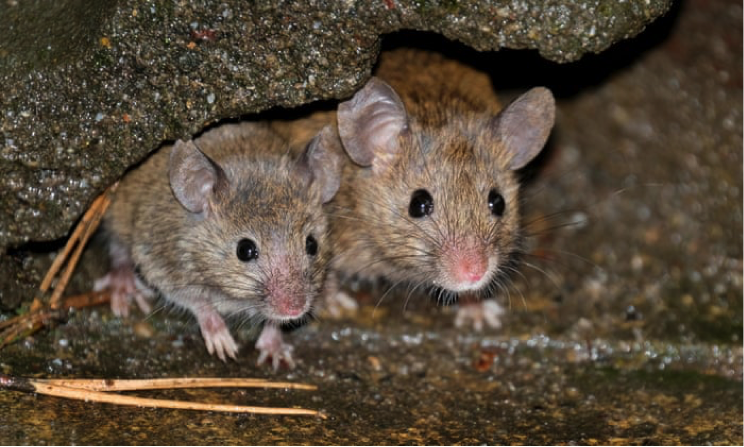
Farallon house mice
But it is time for me to return to bird watching and the marine life along our journey. Next, we sailed westward over the Continental shelf, and were greeted by a change of bird species. Most prominent was the appearance of several black-footed albatrosses, yet another pelagic bird! These large seabirds, with long, narrow wings, dark plumage, and a long, thick bill, used for feeding on the surface of the water, were as curious about us as we were of them. They settled on the water close to the vessel as we stopped to take photographs. The birds roam the north Pacific, but nest primarily on the Hawaiian Islands.

Black-footed albatross
During this part of the journey, we also encountered a blue whale, the largest animal known to have existed, as it surfaced to breathe while eating. There were also several lone mola mola, or sunfish, that we passed, flapping their bodies while lying on their sides near the water’s surface. These strange-looking fish have a truncated body with large head that is equipped with long dorsal and anal fins.
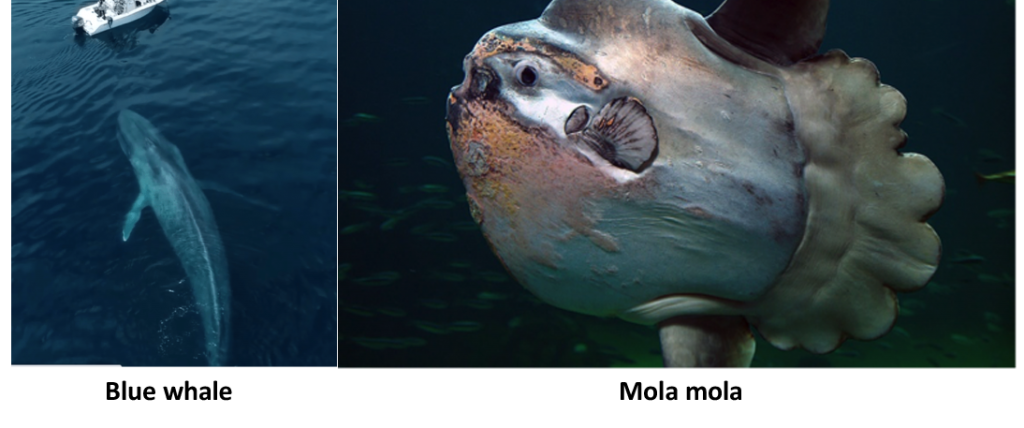
Thus my outing came to an end. It seemed a lengthy journey back to the harbor, with the same sequence of birds that we had spotted earlier, but in reverse order. As soon as cormorants began to fly close to the boat, and brown pelicans reappeared, I knew we were close to land, even though I could not see it. The cormorants were in convoy, flying low over the water, and the pelicans were out fishing. The temperature had risen, my clothing had turned out to be perfect for the weather, the sea swell had almost disappeared, the wind had dropped, and the sun was fighting its way through the high clouds.
I reflected on my birding achievements. I was now able to distinguish between sooty shearwaters, common murres, and pigeon guillemots, without reference to my bird guide, and a more proficient birder on board confirmed the accuracy of my identification.
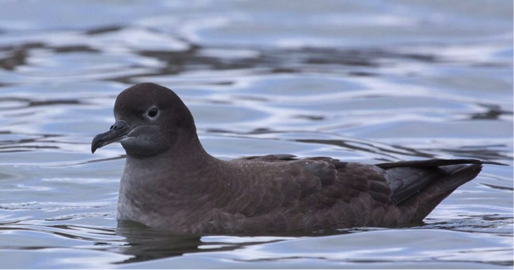
Sooty shearwater

All in all, the outing accomplished its purpose of sharpening my knowledge of California’s pelagic birds and reintroducing me to species I had been familiar with in the UK. The next stage, as I return to birdwatching, will be to improve my knowledge of shorebirds, such as sandpipers, plovers, oystercatchers, and avocets. There are many species in North America and these birds are often migratory and forage for food at their California stop-over sites during their long journeys between the Arctic tundra and their non-breeding locations in the southernmost parts of South America. We disembarked, I bid farewell to my daughter, who left for San Luis Obispo, and I set off for Marin County. I was relieved that I had not experienced seasickness and pleased that the COVID pandemic had caused me to return to my childhood hobby of birdwatching.
